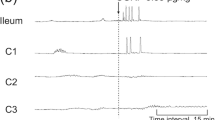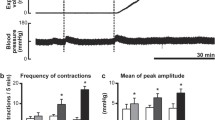Summary
The effect of acute distension on vasoactive polypeptide (VIP)-, neuropeptide Y (NPY)- and substance P (SP)-immunoreactive nerves in the wall of the urinary bladder was investigated. At the age of 3 months, 25 female albino rats underwent forced diuresis combined with balloon obstruction to achieve maximal distension for 3 h. A modified, indirect immunofluorescence detection method was applied 2 days, 7 days and 21 days after distension. A marked, extensive depletion of VIP, NPY-and SP-immunoreactive nerves was observed after distension. This disturbance was reversible, and increased fluorescence of VIP-, NPY- and SP-immunoreactive nerve fibres compared with control specimens was seen in bladder specimens taken even as soon as 21 days after distension. This transient depletion of peptidergic innervation may partly explain the prolonged voiding problems that often occur after acute urinary retention. The depletion of sensory nerves containing SP shortly after distension may explain the transient benefit obtained from distension therapy in patients with painful bladder disease. It is suggested that the increased SP activity during the recovery phase may be related to neurogenic inflammation.
Similar content being viewed by others
References
Allen JM, Adrian TE, Tatemoto K, Polak JM, Hughes J, Bloom SR (1982) Two novel peptides neuropeptide Y (NPY) and peptide YY (PYY) inhibit the contraction of the electrically stimulated mouse vas deferens. Neuropeptides 3:71
Andersson PO, Andersson K-E, Fahrenkrug J, Mattiasson A, Sjögren C, Uvelius B (1988) Contents and effects of substance P and vasoactive intestinal polypeptide in the bladder of rats with and without infravesical outflow obstruction. J Urol 140:168
DeGroat WC, Booth AM (1980) Inhibition and facilitation in parasympathetic ganglia of the urinary bladder. Fed Proc 39:2990
Dunn M, Ramsden PD, Roberts JBM, Smith JC, Smith PJB (1977) Interstitial cystitis, treated by prolonged bladder distension. Br J Urol 49:641
Ekblad E, Edvinsson L, Wahlested C, Uddman R, Håkanson R, Sundler F (1984) Neuropeptide Y co-exists and co-operates with noradrenaline in perivascular nerve fibers. Regul Pept 8:225
Gu J, Islam KN, Restorick J, McGregor GP, Adrian TE, Mundy AR, Bloom SR, Polak JM (1982) Peptidergic innervation of the human urinary tract. Paper presented at the 144th meeting of the Pathological Society of Great Britain and Ireland, Cambridge, UK
Gu J, Restorick JM, Blank MA, Huang WM, Polak JM, Bloom SR, Mundy AR (1983) Vasoactive intestinal polypeptide in the normal and unstable bladder. Br J Urol 55:645
Hedqvist P, Von Euler US (1977) Effects of substance P on some autonomic neuroeffector junctions. In: Von Euler US, Pernow P (eds) Substance P. Raven Press, New York, pp 89–95
Jörgensen L, Mortensen SO, Colstrup H, Andersen JT (1985) Bladder distension in the management of detrusor instability. Scand J Urol Nephrol 19:101
Kinder RB, Restorick JM, Mundy AR (1985) Vasoactive intestinal polypeptide in the hyper-reflexic neuropathic bladder. Br J Urol 57:289
Lundberg JM, Terenius L, Hökfelt T, Marling CR, Tatemoto K, Mutt V, Polak JM, Bloom SR, Goldstein M (1982) Neuropeptide Y (NPY)-like immunoreactivity in peripheral noradrenergic neurons and effects of NPY on sympathetic function. Acta Physiol Scand 116:477
Mattiasson A, Ekblad E, Sundler F, Uvelius B (1985) Origin and distribution of neuropeptide Y-, vasoactive intestinal polypeptide-and substance P-containing nerve fibers in the urinary bladder of the rat. Cell Tissue Res 239:141
Nicoll RA, Schenker C, Leeman SE (1980) Substance P as a transmitter candidate. Annu Rev Neurosci 3:227
Papka RE, Traurig HH, Klenn P (1987) Paracervical ganglia of the female rat: histochemistry and immunohistochemistry of neurons, SIF cells and nerve terminals. Am J Anat 179:243
Pengelly AW, Stephenson TP, Milroy EJ, Whiteside CG, Turner-Warwick R (1978) Results of prolonged bladder distension as treatment for detrusor instability. Br J Urol 50:243
Polak JM, Bloom SR (1983) Regulatory peptides: key factors in the control of bodily functions. Br J Urol 286:1461
Said SI (1981) VIP overview. In: Bloom SR Polak JM (eds) Gut hormones, 2nd edn. Churchill Livingstone, Edinburgh pp 397–384
Sjögren C, Andersson K-E, Husted S (1982) Contractile effects of some polypeptides on the isolated urinary bladder of guinea pig, rabbit and rat. Acta Pharmacol Toxicol 50:175
Sjögren C, Andersson K-E, Mattiasson A (1985) Effects of VIP on isolated urethral and urinary bladder muscle from rabbit and man. J Urol 133:136
Tammela T, Kontturi M, Lukkarinen O (1986) Postoperative urinary retention: II. Micturition problems after the first catheterization. Scand J Urol Nephrol 20:257
Tammela TL, Lasanen LT, Waris T (1990) Effect of distension on cholinergic and adrenergic innervation of the rat urinary bladder. Paper presented at the 20th Annual Meeting of the International Continence Society, Aarhus
Tammela TLJ, Lasanen LT, Waris T (1990) Effect of distension on adrenergic innervation of the rat urinary bladder. Urol Res 18:345
Terenghi G, McGregor GP, Gu J, Huang WM, Morrison JFB, Bloom SR, Polak JM (1983) Substance P-containing sensory fibers in rat bladder originate from pelvic and hypogastric nerves. In: Skrabanek P, Powell D (eds) Substance P. Boole Press, Dublin, pp 161–162
Williams TH, Chiba T, Bhalla RC, Jew J (1976) Species variations in SIF cells of superior cervical ganglia: are there two functional types? In: Eränkö O (ed) SIF cells. Structure and function of the small intensively fluorescent cells Fogarty International Center Proceedings, no 30; DHEW Publications, no NIH-76-942 US Government Printing Office, Washington DC, pp 143–162
Yokokawa K, Sakanaka M, Shiosaka S, Tohyama M, Shiotani Y, Sonoda T (1985) Three dimensional distribution of substance P-like immunoreactivity in the urinary bladder of rat. J Neural Transm 63:209
Author information
Authors and Affiliations
Rights and permissions
About this article
Cite this article
Lasanen, L.T., Tammela, T.L.J., Liesi, P. et al. The effect of acute distension on vasoactive intestinal polypeptide (VIP), neuropeptide Y (NPY) and substance P (SP) immunoreactive nerves in the female rat urinary bladder. Urol. Res. 20, 259–263 (1992). https://doi.org/10.1007/BF00300255
Accepted:
Issue Date:
DOI: https://doi.org/10.1007/BF00300255




